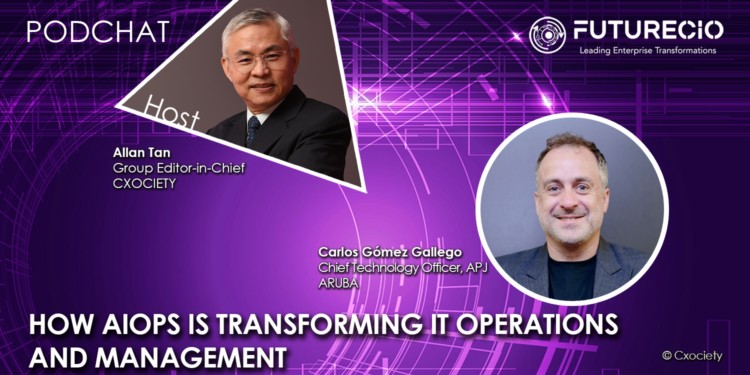Gartner defines AIOps as combining big data and machine learning to automate IT operations processes, including event correlation, anomaly detection and causality determination.
In the State of Innovation: a global survey of IT and Finance Decision Makers, Vanson Bourne reported that 900 technology and finance decision makers agree that innovation would propel their business. At the same time, nearly 90% of survey respondents agreed that their organizations ought to be spending more on innovation and 77% said a major obstacle is “spending too much keeping the lights on.”
A BCG survey of 112 CIO revealed acceptance of AI as significantly improving the cost-effectiveness and performance of IT operations, allowing organisations to drive innovation more quickly without sacrificing security, stability, or service.
Innovation (or competition) is not standing still
Reflecting on its own study, Carlos Gómez Gallego, chief technology officer, APJ at Aruba, affirmed the same adding that customers are looking at how they can leverage AI and ML in particular with regards to network operations, to reduce the amount of time that they have to spend on managing the network and keeping the lights on and start actually getting the network to be an asset that they can leverage to deploy new innovations or new services that they're offering to their customers.
Gallego commented that in the connected economy, the competition is not standing still. Competition is no longer limited to local players or traditional players.
“We have a lot of examples of companies that have come in and disrupted an existing business model or existing go-to market because some of those other companies were complacent and didn't actually look to move forward,” he cautioned.
AIOps misconceptions
Gallego believes the hesitation around the adoption of AI and ML in IT operations stem from the continuing misconception that automation will result in job losses. He repeated what analysts and technology experts have been asserting since the early days of automation: AI and ML is around to augment the IT department.
“Also, to provide them more visibility and more insights into what they can do, in order to make that network perform better for their users,” he continued.
Challenges ahead of AIOps adoption
Gallego noted that implementing AI into existing IT operations will be impacted by data.
“To have a very effective machine learning or AI-driven operation, you need to have access to data, that is good data, that is clean data that is curated data, and it typically has to be in the one place,” he explained.
He lamented the continuing persistence of siloed approach to data storage, including network telemetry data, security data and corporate data. These are often stored in different locations. For Gallego, it is difficult to do machine learning on distributed data sets.
“I think the biggest challenge for companies is to create a data lake that draws inputs from various parts of the organisation, or the various applications and hardware and software that are generating this data,” he added. You need a centralised place to run models from an ML or AI perspective, and draw insights.”
Gallego acknowledged that the act of creating a data lake to store all the data is itself introducing complexity. However, he reasoned that ultimately, the end state leads to a much simpler and efficient way to run from a technology perspective whether it's AIOps related or you even security related or other kinds of insights.
Skills gap
Gallego also concede that introducing AIOps will require upskilling from the technical support engineer right up to the CIO. However, he believed that there is sufficient education and training courses from vendors, learning institutions and industry groups.
“As with everything technology-related, you need to make sure that your staff are trained and up to date on the latest and greatest. If we do not provide an opportunity for our staff to get trained and get up to speed on these new technologies, it is unfair to ask them to suddenly be an expert and dictate what our corporate AI strategy should be,” he opined.
Next step
Any move to adopt AI or ML in IT operations will require being well informed about the options available to you. Gallego said this is important if you are to have an intelligent conversation with your vendor.
He suggested reaching out to vendors and resellers to discussion how to evolve the organisation’s existing infrastructure.
In the Gartner Predicts 2021: Building on Cloud Computing as the New Normal, Gartner analysts recommend that CIOs and CTOs leverage tools, programs and migration methodologies that support the movement to containerization, including tools around ITOps, SecOps, site reliability engineering (SRE), PlatformOps and AIOps.
Click on the podchat player and her Gallego share his perspective on the questions below.
- In Vanson Bourne’s “The State of Innovation,” 77% of those surveyed thought that their organization spent too much time on keeping the lights on. Is this assessment true for many Singapore enterprises? How about enterprises in ASEAN?
- Given our heavy dependence on IT today to power many of our business operations, why should leadership even bother potentially upgrading IT operations (with emerging technologies like AI)? – “if it ain’t broken, why fix it?”
- What are prevailing misconceptions around the use of AI in IT Operations?
- What are the challenges to implementing/integrating AI in IT Operations?
- From your engagement with customers, to what degree are CIO, DC operators and managers familiar with AI as a strategy for improving the management of the IT infrastructure?
- In the case of adoption of AI in ITOps – what has worked and what hasn’t so far? Any learnings to date (both at the C-suite side and at the IT Ops side)?
- What is your advice to CIOs and heads of IT operations when evaluating AI as part of IT Ops?





